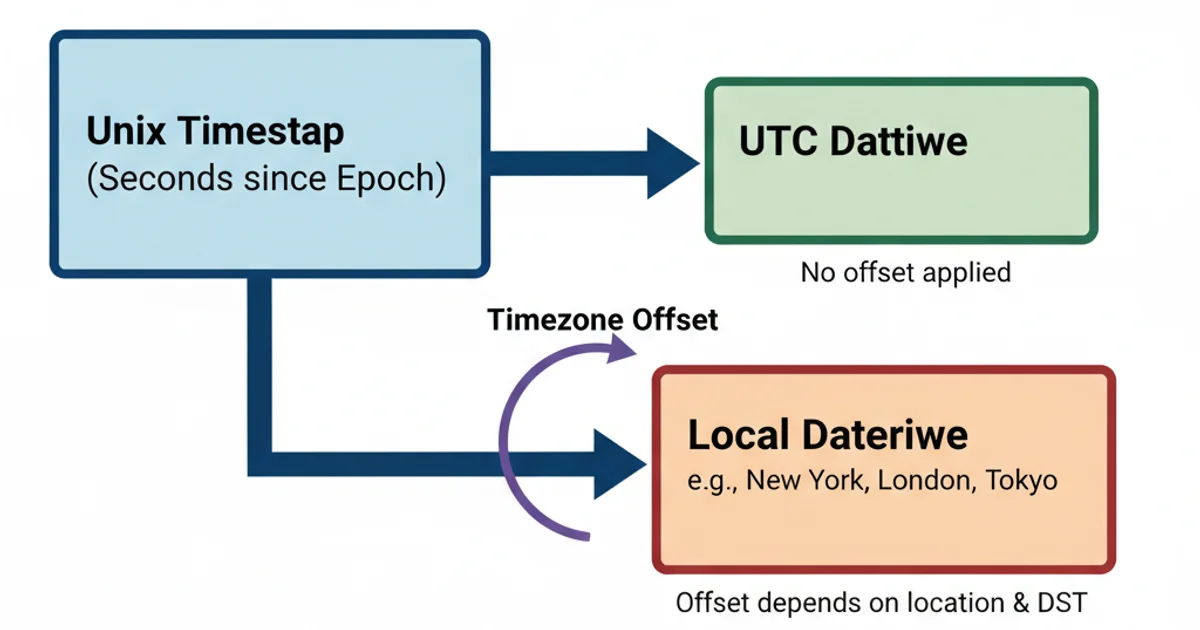DateTime from unix timestamp is wrong
Categories:
Resolving Incorrect DateTime from Unix Timestamps in PHP

Understand and fix common issues when converting Unix timestamps to DateTime objects in PHP, focusing on timezone discrepancies and proper object instantiation.
Converting Unix timestamps to human-readable dates and times is a fundamental task in many applications. In PHP, the DateTime class provides robust functionality for this. However, developers often encounter situations where the resulting DateTime object displays an incorrect time, leading to confusion and data inconsistencies. This article delves into the common causes of these discrepancies, primarily focusing on timezone handling, and provides practical solutions to ensure accurate conversions.
Understanding Unix Timestamps and Timezones
A Unix timestamp is a system for tracking time as a single number: the number of seconds that have elapsed since the Unix epoch (January 1, 1970, at 00:00:00 Coordinated Universal Time (UTC)). Crucially, Unix timestamps are timezone-agnostic; they represent a point in time, not a specific time in a specific timezone. The interpretation of that timestamp into a local date and time depends entirely on the timezone context in which it is viewed or converted.

Unix Timestamp to DateTime Conversion Flow
Common Pitfalls: Default Timezones and Instantiation
The most frequent reason for incorrect DateTime conversions stems from PHP's default timezone settings or how the DateTime object is instantiated. If PHP's default timezone is not explicitly set or is different from the expected timezone, the DateTime object will interpret the Unix timestamp according to its own default, leading to an offset.
PHP's DateTime constructor and createFromFormat method are powerful but require careful use, especially when dealing with timestamps. When you pass a Unix timestamp (as an integer) directly to the DateTime constructor, it's treated as a string, which can lead to unexpected results. The correct way to instantiate a DateTime object from a Unix timestamp is to prefix it with an @ symbol.
<?php
// Incorrect way (treats timestamp as a string, not a timestamp)
$timestamp = 1678886400; // March 15, 2023 00:00:00 UTC
$dateTimeWrong = new DateTime((string)$timestamp);
echo "Wrong: " . $dateTimeWrong->format('Y-m-d H:i:s P') . "\n";
// Correct way to instantiate from a Unix timestamp
$dateTimeCorrect = new DateTime('@' . $timestamp);
echo "Correct (UTC): " . $dateTimeCorrect->format('Y-m-d H:i:s P') . "\n";
// Setting a specific timezone for interpretation
$timezone = new DateTimeZone('America/New_York');
$dateTimeLocal = new DateTime('@' . $timestamp, $timezone);
echo "Correct (New York): " . $dateTimeLocal->format('Y-m-d H:i:s P') . "\n";
// Changing the timezone of an existing DateTime object
$dateTimeCorrect->setTimezone($timezone);
echo "Correct (New York, after setTimezone): " . $dateTimeCorrect->format('Y-m-d H:i:s P') . "\n";
?>
Demonstrating correct and incorrect DateTime instantiation from a Unix timestamp and timezone application.
@ when passing them to the DateTime constructor. Failing to do so can lead to PHP interpreting the timestamp as a date string (e.g., "1678886400" might be parsed as a year 1678 and a time 88:64:00, which is invalid).Managing PHP's Default Timezone
PHP uses a default timezone for all date/time functions if one isn't explicitly provided. This default can be set in your php.ini file, via date_default_timezone_set() function, or by passing a DateTimeZone object to the DateTime constructor. Inconsistent default timezone settings across different environments (development, staging, production) are a common source of errors.
It's best practice to explicitly set the timezone for DateTime objects or ensure your application's default timezone is consistently configured.
<?php
// 1. Set default timezone in php.ini (example entry):
// date.timezone = "America/New_York"
// 2. Set default timezone programmatically (recommended for application entry point)
date_default_timezone_set('Europe/London');
$timestamp = 1678886400; // March 15, 2023 00:00:00 UTC
// DateTime will now use 'Europe/London' as default
$dateTimeDefault = new DateTime('@' . $timestamp);
echo "Default (London): " . $dateTimeDefault->format('Y-m-d H:i:s P') . "\n";
// 3. Override default by passing DateTimeZone object to constructor
$timezoneTokyo = new DateTimeZone('Asia/Tokyo');
$dateTimeTokyo = new DateTime('@' . $timestamp, $timezoneTokyo);
echo "Explicit (Tokyo): " . $dateTimeTokyo->format('Y-m-d H:i:s P') . "\n";
// 4. Change timezone of an existing DateTime object
$dateTimeDefault->setTimezone(new DateTimeZone('America/Los_Angeles'));
echo "Changed (Los Angeles): " . $dateTimeDefault->format('Y-m-d H:i:s P') . "\n";
?>
Methods for setting and managing timezones in PHP.
Practical Steps for Debugging and Resolution
When faced with incorrect DateTime conversions, follow these steps to diagnose and resolve the issue:
1. Verify the Unix Timestamp
Ensure the Unix timestamp itself is correct and represents the expected point in time in UTC. You can use online converters or a simple gmdate('Y-m-d H:i:s', $timestamp) to check its UTC representation.
2. Check PHP's Default Timezone
Use date_default_timezone_get() to see what timezone PHP is currently using. This is often the culprit.
3. Inspect DateTime Object Properties
After creating a DateTime object, use var_dump($dateTimeObject) to inspect its internal state, including the timezone it's currently set to.
4. Explicitly Set Timezone During Instantiation
Always pass a DateTimeZone object to the DateTime constructor when creating from a timestamp, or use setTimezone() immediately after, to ensure the desired timezone is applied.
5. Standardize Timezone Handling
Adopt a consistent strategy for timezone management across your application. Either always work in UTC and convert for display, or ensure a global default timezone is set and respected.
By understanding the nature of Unix timestamps and diligently managing timezone settings in PHP, you can avoid common pitfalls and ensure your date and time conversions are always accurate and reliable.